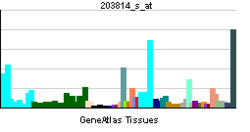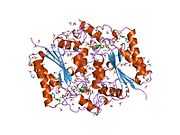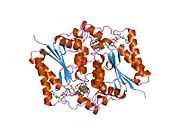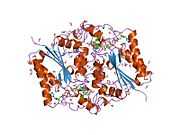NAD(P)H dehydrogenase, quinone 2
| NAD(P)H dehydrogenase, quinone 2 |
|---|

PDB rendering based on 1qr2. |
| Available structures |
| PDB |
Ortholog search: PDBe, RCSB |
| List of PDB id codes |
|
1QR2, 1SG0, 1XI2, 1ZX1, 2BZS, 2QMY, 2QMZ, 2QR2, 2QWX, 2QX4, 2QX6, 2QX8, 2QX9, 3FW1, 3G5M, 3GAM, 3NFR, 3NHF, 3NHJ, 3NHK, 3NHL, 3NHP, 3NHR, 3NHS, 3NHU, 3NHW, 3NHY, 3O2N, 3O73, 3OVM, 3OWH, 3OWX, 3OX1, 3OX2, 3OX3, 3TE7, 3TEM, 3TZB, 3UXE, 3UXH, 4FGJ, 4FGK, 4FGL, 4GQI, 4GR9
|
|
|
| Identifiers |
|---|
| Symbols | NQO2 ; DHQV; DIA6; NMOR2; QR2 |
|---|
| External IDs | OMIM: 160998 MGI: 104513 HomoloGene: 696 ChEMBL: 3959 GeneCards: NQO2 Gene |
|---|
| EC number | 1.10.99.2 |
|---|
|
| RNA expression pattern |
|---|
|
| More reference expression data |
| Orthologs |
|---|
| Species | Human | Mouse | |
|---|
| Entrez | 4835 | 18105 | |
|---|
| Ensembl | ENSG00000124588 | ENSMUSG00000046949 | |
|---|
| UniProt | P16083 | Q9JI75 | |
|---|
| RefSeq (mRNA) | NM_000904 | NM_001163239 | |
|---|
| RefSeq (protein) | NP_000895 | NP_001156711 | |
|---|
| Location (UCSC) | Chr 6:
2.99 – 3.02 Mb | Chr 13:
33.96 – 33.99 Mb | |
|---|
| PubMed search | | | |
|---|
|
NAD(P)H dehydrogenase, quinone 2, also known as NQO2 or QR2, is a human gene. It is a phase II detoxification enzyme which can carry out two or four electron reductions. Its mechanism of reduction is via a covalently bound zinc ion and a cocrystalized FAD. NQO2 contains two chains homologous in AA sequence but 7% different in structure. As a result, NQO2 contains two similar yet unique active sites. An important function of NQO2 is its activation on NRH. NQO2 can be inhibited by resveratrol.[1]
References
Further reading
- Jaiswal AK, Burnett P, Adesnik M, McBride OW (1990). "Nucleotide and deduced amino acid sequence of a human cDNA (NQO2) corresponding to a second member of the NAD(P)H:quinone oxidoreductase gene family. Extensive polymorphism at the NQO2 gene locus on chromosome 6.". Biochemistry 29 (7): 1899–906. doi:10.1021/bi00459a034. PMID 1691923.
- Jaiswal AK (1994). "Human NAD(P)H:quinone oxidoreductase2. Gene structure, activity, and tissue-specific expression.". J. Biol. Chem. 269 (20): 14502–8. PMID 8182056.
- Zhao Q, Yang XL, Holtzclaw WD, Talalay P (1997). "Unexpected genetic and structural relationships of a long-forgotten flavoenzyme to NAD(P)H:quinone reductase (DT-diaphorase)". Proc. Natl. Acad. Sci. U.S.A. 94 (5): 1669–74. doi:10.1073/pnas.94.5.1669. PMC 19974. PMID 9050836.
- Wu K, Knox R, Sun XZ et al. (1997). "Catalytic properties of NAD(P)H:quinone oxidoreductase-2 (NQO2), a dihydronicotinamide riboside dependent oxidoreductase.". Arch. Biochem. Biophys. 347 (2): 221–8. doi:10.1006/abbi.1997.0344. PMID 9367528.
- Foster CE, Bianchet MA, Talalay P et al. (1999). "Crystal structure of human quinone reductase type 2, a metalloflavoprotein.". Biochemistry 38 (31): 9881–6. doi:10.1021/bi990799v. PMID 10433694.
- Jaiswal AK, Bell DW, Radjendirane V, Testa JR (1999). "Localization of human NQO1 gene to chromosome 16q22 and NQO2-6p25 and associated polymorphisms.". Pharmacogenetics 9 (3): 413–8. doi:10.1097/00008571-199906000-00020. PMID 10471077.
- Harada S, Fujii C, Hayashi A, Ohkoshi N (2001). "An association between idiopathic Parkinson's disease and polymorphisms of phase II detoxification enzymes: glutathione S-transferase M1 and quinone oxidoreductase 1 and 2.". Biochem. Biophys. Res. Commun. 288 (4): 887–92. doi:10.1006/bbrc.2001.5868. PMID 11688992.
- Strassburg A, Strassburg CP, Manns MP, Tukey RH (2002). "Differential gene expression of NAD(P)H:quinone oxidoreductase and NRH:quinone oxidoreductase in human hepatocellular and biliary tissue.". Mol. Pharmacol. 61 (2): 320–5. doi:10.1124/mol.61.2.320. PMID 11809856.
- Strausberg RL, Feingold EA, Grouse LH et al. (2003). "Generation and initial analysis of more than 15,000 full-length human and mouse cDNA sequences.". Proc. Natl. Acad. Sci. U.S.A. 99 (26): 16899–903. doi:10.1073/pnas.242603899. PMC 139241. PMID 12477932.
- Okubo T, Harada S, Higuchi S, Matsushita S (2004). "Association analyses between polymorphisms of the phase II detoxification enzymes (GSTM1, NQO1, NQO2) and alcohol withdrawal symptoms.". Alcohol. Clin. Exp. Res. 27 (8 Suppl): 68S–71S. doi:10.1097/01.ALC.0000078616.63296.41. PMID 12960511.
- Ostrousky O, Meged S, Loewenthal R et al. (2004). "NQO2 gene is associated with clozapine-induced agranulocytosis.". Tissue Antigens 62 (6): 483–91. doi:10.1046/j.1399-0039.2003.00133.x. PMID 14617031.
- Harada S, Tachikawa H, Kawanishi Y (2005). "A possible association between an insertion/deletion polymorphism of the NQO2 gene and schizophrenia.". Psychiatr. Genet. 13 (4): 205–9. doi:10.1097/01.ypg.0000071601.59979.47. PMID 14639047.
- Ota T, Suzuki Y, Nishikawa T et al. (2004). "Complete sequencing and characterization of 21,243 full-length human cDNAs.". Nat. Genet. 36 (1): 40–5. doi:10.1038/ng1285. PMID 14702039.
- Kwiek JJ, Haystead TA, Rudolph J (2004). "Kinetic mechanism of quinone oxidoreductase 2 and its inhibition by the antimalarial quinolines.". Biochemistry 43 (15): 4538–47. doi:10.1021/bi035923w. PMID 15078100.
- Buryanovskyy L, Fu Y, Boyd M et al. (2004). "Crystal structure of quinone reductase 2 in complex with resveratrol.". Biochemistry 43 (36): 11417–26. doi:10.1021/bi049162o. PMID 15350128.
- Wang W, Jaiswal AK (2005). "Sp3 repression of polymorphic human NRH:quinone oxidoreductase 2 gene promoter.". Free Radic. Biol. Med. 37 (8): 1231–43. doi:10.1016/j.freeradbiomed.2004.06.042. PMID 15451063.
- Gerhard DS, Wagner L, Feingold EA et al. (2004). "The status, quality, and expansion of the NIH full-length cDNA project: the Mammalian Gene Collection (MGC).". Genome Res. 14 (10B): 2121–7. doi:10.1101/gr.2596504. PMC 528928. PMID 15489334.
- Hsieh TC, Wang Z, Hamby CV, Wu JM (2005). "Inhibition of melanoma cell proliferation by resveratrol is correlated with upregulation of quinone reductase 2 and p53.". Biochem. Biophys. Res. Commun. 334 (1): 223–30. doi:10.1016/j.bbrc.2005.06.073. PMID 15993843.
- Fu Y, Buryanovskyy L, Zhang Z (2005). "Crystal structure of quinone reductase 2 in complex with cancer prodrug CB1954.". Biochem. Biophys. Res. Commun. 336 (1): 332–8. doi:10.1016/j.bbrc.2005.08.081. PMID 16129418.
- Rual JF, Venkatesan K, Hao T et al. (2005). "Towards a proteome-scale map of the human protein-protein interaction network.". Nature 437 (7062): 1173–8. doi:10.1038/nature04209. PMID 16189514.
PDB gallery |
|---|
| | 1qr2: HUMAN QUINONE REDUCTASE TYPE 2 |
| 1sg0: Crystal structure analysis of QR2 in complex with resveratrol |
| 1xi2: Quinone Reductase 2 in Complex with Cancer Prodrug CB1954 |
| 1zx1: Human quinone oxidoreductase 2 (NQO2) in complex with the cytostatic prodrug CB1954 |
| 2bzs: BINDING OF ANTI-CANCER PRODRUG CB1954 TO THE ACTIVATING ENZYME NQO2 REVEALED BY THE CRYSTAL STRUCTURE OF THEIR COMPLEX. |
| 2qr2: HUMAN QUINONE REDUCTASE TYPE 2, COMPLEX WITH MENADIONE |
|
|
|







